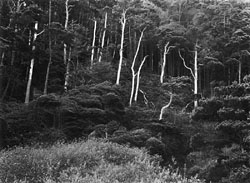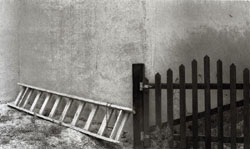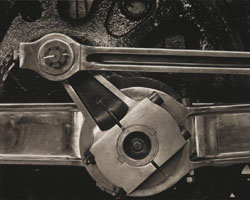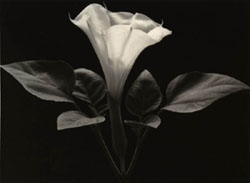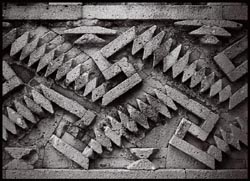 |
|||
|
|
|
Carbon Transfer by Sandy King On August 15-17, 2008 Bostick & Sullivan hosted a Symposium on carbon printing. The group was relatively small but the work shown was of high quality, with many print styles represented, including multi-transfer high relief prints by Gordon Chapple, rich double transfer prints by Gary Baker, low relief work by Phil Schwartz, prints on aluminum by Bob Herbst, and high relief single transfer work by the author, along with work by many other carbon printers. Because of the fact that carbon printing is not as widely practiced as other alternative processes such as gum bichromate, Vandyke and Pt./Pd., many carbon printers have learned the craft in relative isolation from other workers, which has resulted in a rather wide range of printing styles. This article will provide some details of the printing methods of several contemporary master carbon printers, along with brief commentary on the history of carbon printing and the image qualities of carbon printing. Brief Comments on the History of Carbon Printing The roots of carbon printing are found in the experimental work of Louis Poitevin in the mid-19th century. Carbon printing, more or less as we know it today, was introduced in1864 by Joseph Swan, who built on the experimental work of Poitevin and created a practical method of making carbon prints. Swan used a paper support, coated on one side with a pigmented-gelatin solution. After sensitization and exposure the tissue was transferred to a temporary rubber support for development. When dry, the resulting pigment image was transferred to its final paper support. Swan began marketing carbon materials in 1866, offering his ready-made tissue in three colors: black, sepia and purple-brown. Carbon was the preferred process of the top echelon of commercial photographers in the second half of the 19th century. Price lists of commercial printing houses of the period show that prints made by the carbon process were very expensive, often two or three times more than those of prints made by any other process, including platinum. Materials for carbon printing were widely available in Europe and in North America from the second part of the 19th century until the early 1950s. The last major manufacturer of carbon tissue, Hanfstaengle of Munich, Germany, ceased production of carbon tissue in the late 1980s and for many years there was no commercial source of carbon tissue. In 2004 Bostick and Sullivan in Santa Fe, New Mexico began to produce carbon tissue for monochrome work. I reviewed the B&S tissue in an article entitled “Pigment Printmaking with Carbon,” which was published in the Jan/Feb 2004 issue of View Camera. Since 2004 the quality of the carbon tissue produced by B&S has been considerably improved and is now offered in a greater range of colors. Image Qualities of Carbon Prints The carbon and carbro processes offer a number of unique attributes.
Print collectors should be aware that carbon prints are far less common on the antiquities market than other types of historical prints, more so in North America than in Europe. Characteristics which help in their identification include: 1) unusual colors, 2) visible pigment particles, 3) glossy shadows contrasting with matte highlights, 4) surface relief, and 5) Gelatin crazing, which resembles the surface cracking of tempera paintings, is sometimes seen in very old carbon prints. This article will now look at the work of several very accomplished carbon printers who participated in the Carbon Symposium in Santa Fe. A brief description of their working methods will be shown, along with some of the work that they had on display at the symposium. Click on the images below and the artist’s work will open in a separate window.
Conclusion In its versatility and range of possibilities carbon is a superb process. Unlike all other processes, whose image characteristics are closely linked to the inherent characteristics of the process, carbon is capable of presenting images with a wide range of image characteristics, of virtually any color or tone, and on a wide variety of surfaces. Although carbon printing is a fairly complicated and time consuming process the final result, which is highly unique compared to all other photographic processes, historical and contemporary, is deemed to be well worth the effort by the artists who have contributed their work to this article.
|
|||||||||||||||||||||||||||||||||||||||||||||||||||||||||||||||||||||||||||||||||||||||||||||||||||||||||||||||||||||||||||||||||||||||||||||||||||
|
|
|
|
